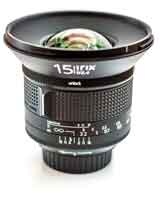Irix 15mm f/2.4 Firefly
Having switched to FX with the purchase of a used Nikon D600, I was looking for a worthy full-frame successor to my Sigma 10-20mm f/4-5.6 EX DC. After pinning my hopes on the Sigma 14mm f/1.8[a] and having them dashed when seeing the price of that lens, I decided on the Irix 15mm f/2.4. Not quite as wide-angled as the Sigma, and not quite as fast - but half the weight and a quarter of the price.

15mm f/2.4 Firefly
Fast ultra-wide prime lens for FX sensors
- Specifications
- VR Image stabilization
- No
- Focus motor
- No (Manual focus only)
- Focal length
- Actual
- 15 mm
- Aperture
- Min
- f/2.4
- Max
- f/22
A worthy full-frame successor to my Sigma 10-20 f/4. (5/5)
1. The Lens
The Firefly is a light and very portable lens. The single annoying thing about its construction is the flared mushroom-like projection at the front. It adds diameter to the lens, making it harder to fit the lens in a camera bag, but doesn't really add anything else. If it could be removed (and the lens cap can be replaced with a plastic lens hood), the Firefly would be much easier to haul around.
2. Astrophotography
Following the calculations on Lonely Speck's guide to lenses[b], the Irix 15mm scores a solid 1352 points, putting it between the Zeiss Otus 55mm f/1.4 and the Nikkor 35mm f/1.8G, and above the popular Rokinon 14mm f/2.8 which sits at 1032.
Lonely Speck, however, makes a slight mistake in their calculations - they assume a 24 mm x 16 mm sensor, but proceed to use the 500 / focal length approximation when computing the exposure time. Correcting for this by using full-frame throughout, the champion Lonely Speck lens, the Fujinon XF 16mm/1.4, scores a massive 6966 points. The Irix 15mm f/2.4 scores a more modest 2418 points; which is still above the Rokinon at 1808.
Compared to my Sigma 10-20mm f/4-5.6 EX DC, which scores a humble 384 points (corrected), it is quite a step up. See Astrophotography Lens and Camera Score Calculator for more about this.
3. Sharpness
When focused at infinity, the lens reaches maximum sharpness (for objects at infinity) at f/5 - f/7.1. When focused at the hyperfocal distance, it reaches maximum sharpness at infinity at f/8 (but objects close to the camera will of course be sharper than if the lens was focused at infinity).
4. Samples
5. Summary
A great, light and cheap ultra wide prime lens with a large aperture. The price is low, but there's nothing about the performance of the lens that is cheap.
In my review of the Sigma 10-20mm f/4-5.6 EX DC, I noted that if there is anything I'd change on this lens it would be to get rid of the zoom and make it a 10mm prime
. The Irix is pretty much just that; but with a larger aperture.







